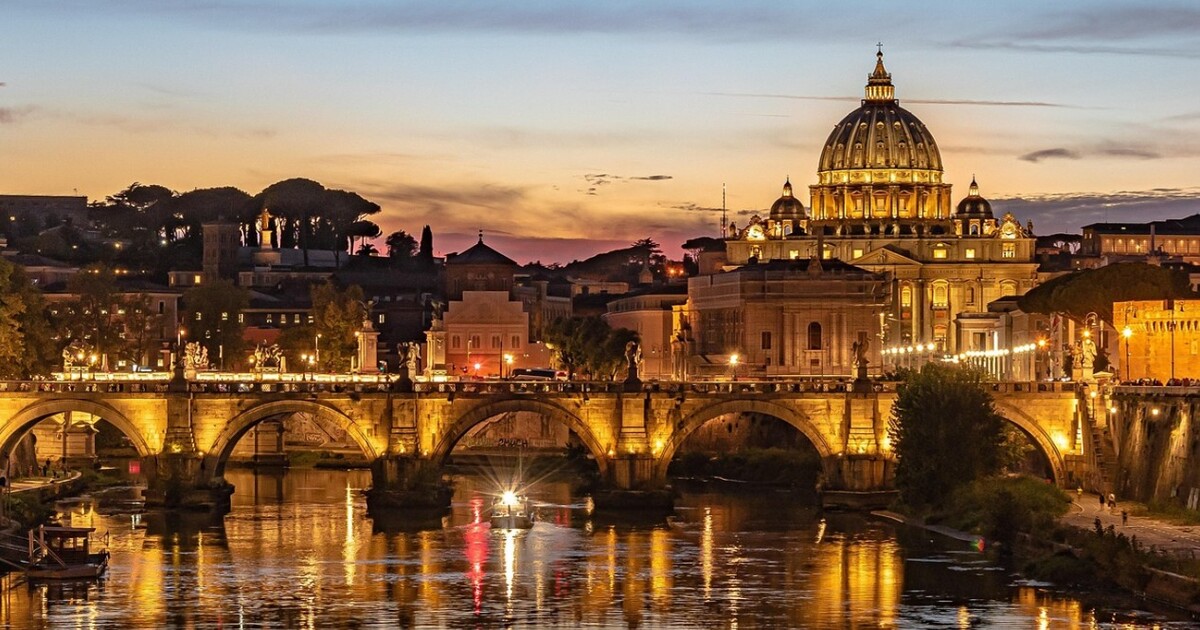Rome: City of the Sinless?
Notes from the Italian capital at the start of the Catholic Church’s Jubilee Year 2025 caught between Airbnb touristification and “anti-degradation” strategies.
January 19, 2025

“Veni Romam, ut remittantur peccata tua!” (Come to Rome, and have all your sins forgiven!)
Convinced? Perhaps not. Well, it is a tried and tested slogan, marketed from Pontiff to pulpit to pilgrim since 1300 when Pope Boniface VIII convoked a holy year.
Thereafter every 25 or 50 years, Rome opened its doors for the Jubilee Year. The deal is simple enough — pilgrimage to a holy site, take communion and all your sins — yes all of them — are forgiven.
This time around, from the 24th of December 2024 to January 6th, 2026, if you enter any of the major churches of Rome you can receive God’s grace and be absolved.
What a deal
It makes you wonder — over the centuries — how many people made a mockery of these temporal boundaries. Because, in ecclesiastical theory, you could gamble, covet, murder, steal and blaspheme your way all through 2025 only to hastily make your way to Santa Maria Maggiore for midnight mass on January 5th, 2026.
You recite the old incantations, receive communion and leave safe in the knowledge that the Almighty’s forgiveness has washed over you.
“Annus Iubilaeus — praestatur absolutio!” (The Jubilee Year — absolution guaranteed!)
I am making these particular words up in case you cannot tell, but if anyone from the Vatican needs help in their marketing department I’m your guy.
I doubt they need me. Millions of Catholics, from Managua to Manila, are already packing their bags for Rome.
No room at the inn
In 2023, the total number of tourists flocking to Rome were 35 million. This year, over 30 million pilgrims are expected, but they may be the only ones who find accommodation.
With housing in Rome already teetering on the precipice, the Jubilee Year is tipping the crisis over the edge. More and more apartment owners are opting to offer their properties to short or medium-term tourist rentals.
I am sure there is a Latin adage for “make an easy buck during the Jubilee year!” Less obvious is the countervailing aphorism that sums up the growing multitude of residents for whom housing is prohibitively expensive or outright unavailable.
Airbnb Surge
Between June and September 2024 alone, nearly 3,200 new listings for short-term rentals appeared on Airbnb in the Italian capital. Tourists and travelers can now choose from 24,912 properties.
By comparison, a search on Immobiliare.it for long-term rentals yielded a paltry 3,283 results for the greater Rome area.
It is a phenomenon known as the “touristification” of the housing market. A report conducted by SoloAffitti and Izi Lab found that this Jubilee Year will reduce the supply of medium and long-term rentals, driving up prices by 17%.
A friend of mine has been booted out by her aunt who owns a property ten minutes from Termini — the main central station. Her aunt had calculated she could expect to make 30,000-40,000 euros out of her two-bedroom apartment for the duration of the Jubilee Year.
That is over three thousand a month or more than six times what her niece could offer. Against the bright green allure of piles and piles of money, my friend never stood a chance.
A growth industry
What my friend’s aunt knows is borne out by market indicators. The Tecnocasa Group’s Real Estate Observatory confirmed that there is enormous appetite for holiday home purchases in Rome, with investors ready to spend as much as 700,000-800,000 euros for a property to then be partitioned and rented out to tourists and pilgrims.
But how many of those homes will return to Rome’s usual inhabitants after the Jubilee Year? How many landlords will accept the precipitous decrease in their passive income when the pilgrims leave?
This is not a new phenomenon. After all, Airbnb was created in 2007 and the Jubilee in the 14th century. But this year has focused the fury of Romans like never before and sparked several campaigns.
The rent regulatory labyrinth
Take, for example, the Roman Group for the Regulation and Oversight of Short-Term Rentals, GRoRAB. They have been urging the municipality of Rome to take action. Last July, the group released a manifesto opposing “touristification” and launched a campaign outlining several demands to the city council.
For over a year, the council has been working to amend the Technical Implementation Rules of the 2008 General Regulatory Plan to regulate hospitality activities in the historic center. The proposed amendment includes identifying “saturated zones” where new vacation rentals would be prohibited.
According to a motion submitted by the Democratic Party (PD) in Rome and approved by the city council last November, this measure will, at best, be implemented by spring — a third of the way through the current Jubilee.
The quagmire of Italian bureaucracy
If this sounds confusing, that is because it is. Navigating the regulatory minefield and coming up with concrete ways to tackle Rome’s housing problem is a classic example of the Kafkaesque quagmire of Italian bureaucracy.
The real trouble is that there is no national legislation that gives municipalities clear and defined authority to address this issue. At best campaigners like GRoRab are relying on the technicalities of the regulatory plan to impose limits on the spread of short-term rentals.
So, if there is no national legislation, what is the government up to? Italy is run by a far-right coalition government comprised of Prime Minister Giorgia Meloni and her neo-fascist party, Fratelli D’Italia and Matteo Salvini, who heads the Lega party.
There has been scant evidence that they are concerned with the crisis brought about by over-tourism. Instead, the Jubilee Year furnishes other clues to the direction of their priorities.
Law and order in the name of “anti-degradation”
Back at the end of September, law enforcement, along with municipal police and workers from the municipal waste management company, AMA, cleared dozens of people who had set up camps on Viale Pretoriano, along the Aurelian Walls, between Termini Station and the San Lorenzo district.
To prevent their return, a fence was erected to prevent blankets or cardboard from being re-laid on the grassy area.
Repeated throughout 2024 and set to continue this year, such clearances have been defined as part of “anti-degradation” measures. Euphemisms like “anti-degradation” are pure examples of Orwellian double-speak.
They are best situated alongside the political inclinations of a far-right government focused on cleansing Rome of those they deem unsightly and preparing it for the huge wave of tourism and the money they will bring into the city.
Where did the authorities send those camped along the Aurelian walls? Few alternatives have been provided by the city’s reception system or efforts made to address Rome’s housing insecurity.
Instead, the authorities set up four tents to provide shelter and assistance for the homeless. These four tents, capable of sheltering a maximum of 70 people, have been scattered across the city. Fewer than 300 people will be able to take advantage of these spaces. Over 20,000 people live on the streets of Rome.
“Red Zones”
Instead of prioritizing the provision of shelter, the Ministry of the Interior, headed up by Matteo Piantedosi, a political independent but personally close to Matteo Salvini, the head of the far-right Lega Party, has eagerly demarcated the borders of these newly defined “red zones.”
Having already been launched in Bologna and Florence, Rome’s Termini and neighboring Esquilino area, famous for its Chinese and South Asian diaspora communities, are next.
At the close of the year, on December 30,2024, Piantedosi issued a directive to prefects, urging them to use special ordinances to designate urban areas where individuals deemed dangerous or with criminal records would be forcibly removed and banned.
Law enforcement officials are free to kick out or lock up anyone they chose from railways stations, nightlife areas — any area with a high concentration of people.
The impact has already been felt in Florence and Bologna where men in uniforms stopped and checked over 14,000 people over the past three months, removing 105 individuals following the special security ordinance.
Now, it is Rome’s turn as the Jubilee year unfolds and already it is seen and felt with many more police visible on almost every street corner.
The great eviction
Compounding the issue of forcibly removing the homeless is that their numbers are rising. In 2023, out of 3,528 eviction orders in Rome, 2,058 were carried out — an average of more than five evictions a day.
According to the latest Caritas Report on Poverty in Rome, sifting through data provided by the Ministry of the Interior, the inability to pay rent due to an unforeseen event such as the loss of a job, accounted for 85%.
Rome’s housing emergency did not begin this year. In the capital there are more than 18,000 families waiting for public housing, 20,000 homeless people and 10,000 households under threat of eviction — numbers that indicate the difficulties the city faces daily.
The Jubilee Year has thrown into sharp relief the fault lines in Rome’s housing crisis. Towards the top, the middle classes are being squeezed by the easy money promised by tourism while working families are facing eviction threats. And those who are already scratching their survival on the streets are now confronted by law enforcement officials ruthlessly moving them out of the way.
A home is a right
I have not yet found whether, upon inaugurating the first Ano Jubileo in 1300, Pope Boniface VII also rolled out a careful and considered set of housing reforms to address the rampant social inequalities that plagued (literally) medieval Rome.
Nor is it easy to find how many more pilgrims would come to Rome during a Jubilee Year in the Middle Ages. But Rome lived on and kept going.
It is tempting to exaggerate this slim consolation that, after all, La Cittá Eterna and its citizens have survived seven centuries of Jubilee Years.
An overwhelming year
As before, Romans are bracing themselves for what is sure to be an overwhelming year. But they should not conflate past survival as evidence of a promise of future prosperity or confuse the dilemma of the present crisis.
Rome’s Jubilee Year is a magnifying glass for a country-wide housing crisis, the schematic of which is seen repeated in almost every major Italian city.
Salvini and Meloni are not going to defend the interests of the working class and poor who face evictions and insurmountable living costs. Instead, they are happy to see Rome being reordered, its streets cleansed and houses readied in the name of tourism.
It sets a dangerous precedent as it emboldens law enforcement during a time of a far-right government, keen on “anti-degradation” measures.
Grass roots campaigns may find that they are resisting more than they bargained for as they fight for more than the inalienable la casa è un diritto — right of a home.
Takeaways
Rome's Jubilee Year 2025 is a magnifying glass for a country-wide housing crisis, the schematic of which is seen repeated in almost every major Italian city.
Salvini and Meloni are not going to defend the interests of the working class and poor who face evictions and insurmountable living costs. Instead, they are happy to see Rome being reordered, its streets cleansed and houses readied in the name of tourism.
Come to Rome and have all your sins forgiven! It is a tried and tested slogan, marketed from Pontiff to pulpit to pilgrim since 1300.
Tourists and travelers can now choose from 24,912 properties in the Italian capital on Airbnb. A search on Immobiliare.it for long-term rentals yielded a paltry 3,283 results for the greater Rome area.
Navigating the regulatory minefield and coming up with concrete ways to tackle Rome’s housing problem is a classic example of the Kafkaesque quagmire of Italian bureaucracy.
Rome's housing emergency did not begin this year. In the capital there are more than 18,000 families waiting for public housing, 20,000 homeless people and 10,000 households under threat of eviction.
The Jubilee Year has thrown into sharp relief the fault lines in Rome’s housing crisis. Towards the top, the middle classes are being squeezed by the easy money promised by tourism while working families are facing eviction threats.

